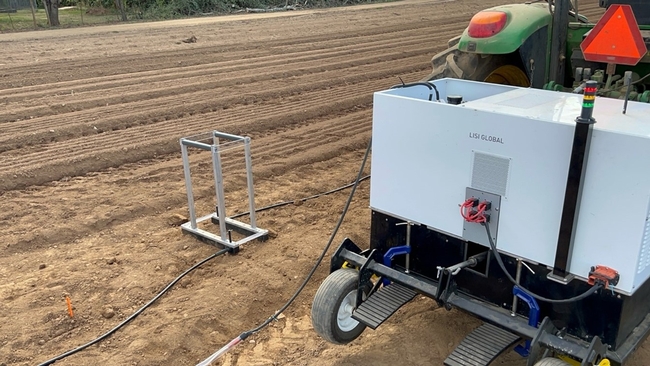I'll share some initial findings from our project, which explores the use of pulse electric fields to eliminate soil pests in hardwood nursery beds, with a particular focus on the impact on weed populations.
Pulse Electric Field as an Alternative to Methyl Bromide
Methyl bromide, a broad-spectrum pesticide for soil disinfection, weed control, and soilborne fungi and nematodes management, is also notorious for its ozone-depleting properties. Consequently, its usage in agriculture has been progressively phased out. Though some essential applications persist, the increasing costs and stringent regulatory standards have made it a less practical choice for pest control.
Pulse Electric Field (PEF) – A New Approach
Pulse electric field (PEF) employs bursts of high-voltage electricity to deactivate microorganisms (see Figure 1). Although primarily utilized in the food industry, there have been encouraging reports of its effectiveness in controlling nematodes and plant diseases (Riga et al., 2020). In our collaboration with Lisi Global, we are adapting this technology for a novel application within the ornamental nursery industry.
The precise mechanism by which PEF eliminates organisms remains a subject of ongoing study. It may involve cell membrane rupture, accompanied by metabolic shutdown, or the absorption of energy by specific proteins leading to the generation of cell-damaging free radicals. Alternatively, protein structures may be altered, rendering them non-functional. The non-thermal nature of PEF is generally accepted, but the results may vary depending on the energy applied to the soil.
Treating Soil with PEF
Treating soil with PEF involves sandwiching soil between two electrodes for the required duration to deliver the desired energy. The goal is to maintain a high voltage current between the electrodes. In the short term, energy is stored briefly in a capacitor, and factors like voltage, pulse number, duration, and frequency can be adjusted to control the energy delivered. The distance between electrodes also impacts PEF performance, as the soil's resistance affects the flow of current.
Impact of PEF on Weeds
Surprisingly little is known about the effects of PEF on weeds, prompting us to initiate pot studies to determine effective rates. Controlled greenhouse experiments help eliminate the variability often encountered in the field and provide a solid starting point for treatment guidelines. For reference, a previous study (Riga et al., 2020) demonstrated that 25 J cm^-3 could control over 90% of nematodes. In our experiments, 480 J cm^-3 produced enough energy to generate heat, water vapor, and even melt the pots (see Figure 2), challenging the notion that PEF cannot be a thermal soil sterilant.
https://youtu.be/SV9zoXpvn84?si=RQh_ctDkIR-jD3ZL
For weeds, electrical rates of 60 J cm^-3 or higher effectively eliminated nearly all yellow nutsedge tubers, although a few crabgrass plants did emerge after treatment with 125 J cm^-3. We are currently expanding our research to other weed species and exploring methods to enhance efficacy. Our ultimate goal is to determine the minimum energy required to consistently control a mixture of weed species.
The Next Step: Field Validation
This autumn, we will commence field studies in collaboration with Oregon nurseries. We are pushing ahead on multiple research fronts as we pioneer this new application for PEF. The development of new technology is invariably challenging and resource-intensive. Adapting existing technology to a new purpose presents multiple hurdles, with one significant challenge being that the energy levels required for soil disinfestation exceed the original equipment design limits. This places substantial strain on the batteries, cooling system, and electronics, all of which have pushed the boundaries of their capabilities.
Acknowledgments
This project is generously funded by the USDA-NIFA Methyl Bromide Transition Program (2022-51102-38259), the Horticulture Research Institute, and the Oregon Association of Nurseries. We extend our sincere gratitude to our collaborators, J. Frank Schmidt & Son Nursery in Boring, OR, and Robinson Nursery in McMinnville, OR, without whose support this work would not have been possible.
Reference
Riga, E., Crisp, J.D., McComb, G.J., Weiland, J.E. and Zasada, I.A., 2020. Directed energy system technology for the control of soilborne fungal pathogens and plant?parasitic nematodes. Pest management science, 76(6), pp.2072-2078.
Original source: Weeders of the West blog ¦ Nov. 9, 2023


